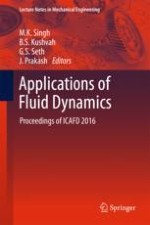2018 | OriginalPaper | Chapter
Numerical Investigation of Hypersonic Flow Past a Spherically Blunted Nose Cone
Authors : Ashish Narayan, Rakesh Kumar, S. Narayanan
Published in: Applications of Fluid Dynamics
Publisher: Springer Singapore
Activate our intelligent search to find suitable subject content or patents.
Select sections of text to find matching patents with Artificial Intelligence. powered by
Select sections of text to find additional relevant content using AI-assisted search. powered by
